Contents
When choosing pears, they are guided by the taste and quality of fruits, resistance to cold and diseases. Domestic hybrids are adapted to conditions and do not lose their relevance. Description, photos and reviews of the Dessert Rossoshanskaya pear will help gardeners grow a productive tree on their site.
Description of the pear variety Rossoshanskaya
The Rossoshanskaya pear is the result of the work of domestic breeders. Varieties bred at the Rossoshanskaya experimental station. The institution is located in the south of the Voronezh region and is engaged in the creation of new varieties.
The first pear of the Rossoshanskaya variety was bred in 1952 and was named Dessertnaya. In the future, other varieties appeared – Beautiful, Early and Late. On the basis of the Rossoshan varieties, hybrids Tihiy Don, Severyanka, Nerussa were obtained.
According to the description of the variety and photo, the Rossoshanskaya pear is a medium or vigorous tree. The crown is pyramidal or rounded. The pear reaches a height of 3-4 m. The leaves of the plant are ovate, pointed, 5-10 cm long. In autumn, they acquire a yellow-orange hue. The flowering of the variety occurs in May. The flowers are collected in brushes of 4 – 9 pcs.
Depending on the variety, the fruits are elongated or rounded. Universal application: fresh consumption, drying, obtaining jams, compotes, juices.
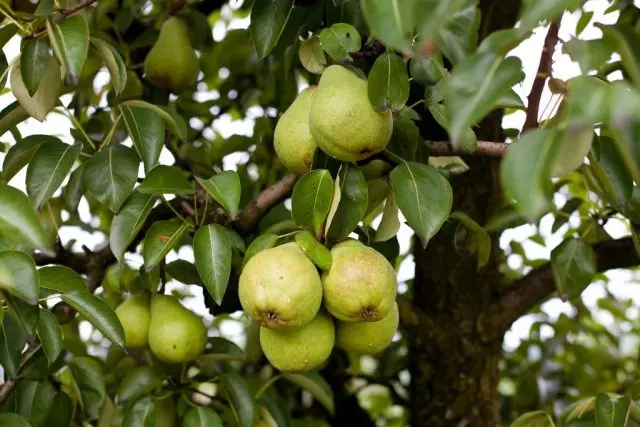
Varieties
There are 4 varieties of Rossoshanskaya pear, which differ in the period of ripening and the appearance of the fruit.
Pear Dessert Rossoshanskaya
The hybrid was included in the State Register in 1965. Pear is recommended to grow in the Central and Central Black Earth region.
The culture has the appearance of a medium-sized tree. The variety has a crown of rounded shape, medium density. The bark is gray, the shoots are brown. The leaves are green, large, with pointed tips. The leaf plate is smooth, curved. Flowers white, large.
The fruits are flattened and weigh about 190 g. The skin is smooth, non-rigid, light yellow with a raspberry blush. The pulp is a little dense, beige, it releases a lot of juice. It tastes sweet and sour, with a faint aroma. Tasting properties are estimated at 4,5 points. The fruits are well transported, the shelf life is from 100 to 146 days. Application is universal.
The variety Dessertnaya Rossoshanskaya has a high winter hardiness. When the temperature dropped to -38 °C, freezing was 1,4-1,8 points. These are weak injuries, in which part of the generative buds and annual shoots die.
The tree tolerates drought well. During the growing season, it is damaged by septoria and sucker. Scab resistance is high.
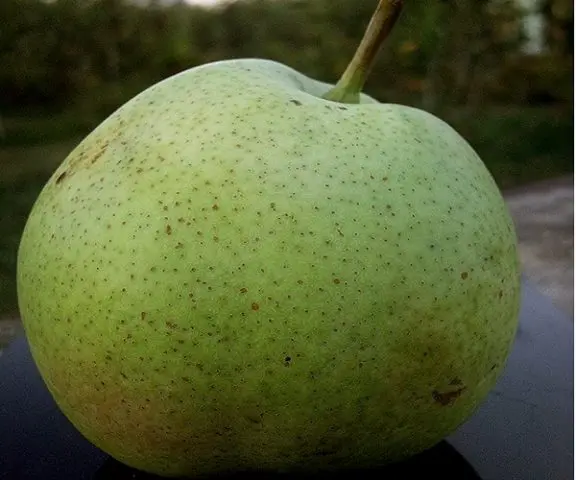
Pear Rossoshanskaya Beautiful
The variety Rossoshanskaya Beautiful was obtained by crossing the variety Tonkovetka Mlievskaya and Lyubimitsa Klappa. In 1986 it was entered into the State Register. The variety is common in the southern regions of the Black Earth region, in the North Caucasus and in the Volga region.
Trees are vigorous, have a pyramidal crown. The crown is sparse, the bark is dark gray, the skeletal branches are brownish. Shoots are long and straight. The leaves are green, shiny, medium in size. Buds are pink and white.
The fruits of the pear Rossoshanskaya Beauty are medium in size, weigh 120 g. The shape is pear-shaped, elongated. The skin is smooth, non-rigid, white-yellow, covered with green dots. Blurred, red color. Inside the pear is a yellowish hue, juicy, sweet with a sour taste. The variety was awarded a tasting score of 4 points. Fruits hang on branches for a long time until ripening. The pear is well stored and transported.
The winter hardiness of the variety is high. At a temperature of -34 ° C, the degree of freezing of shoots is up to 1,3 points. Drought tolerance is average. With a lack of moisture, the fruits shrink. Inflorescences do not tolerate spring frosts.
Scab resistance is average. In the conditions of the Voronezh region, a tree rarely gets sick. More often, signs of the disease appear when landing in the Oryol region.
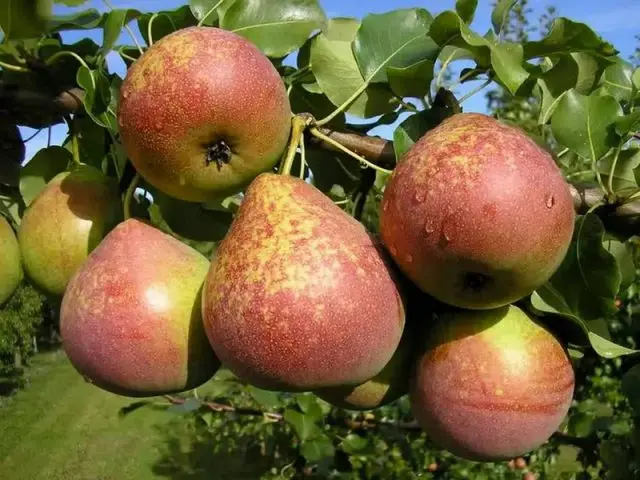
Pear Rossoshanskaya Late
It is considered one of the best among winter varieties. The fruits are enlarged, weighing 250 – 350 g. The shape is round, the color is yellow-green. When ripe, the skin turns yellow. Under the influence of the sun, a red blush appears.
According to the description, the late Rossosh pear has a good taste and presentation. The flesh is beige, tender, with a pronounced aroma. Harvested in mid to late September. The storage period is until February. If you remove the fruits later, then the pulp gains more sugar. This reduces the storage time of the pear.
The tree is medium-sized, has a rounded crown. Winter hardiness is high, at a temperature of -32 ° C, freezing is estimated at 1,5 points.
Pear Rossoshanskaya Early
The variety was obtained by pollinating the seedlings of the pear Marble and Rossoshanskaya Krasivaya. Since 1995 it has been undergoing variety testing. Tree of medium or large vigor. The crown is not thickened. The bark on the trunk is dark gray.
Shoots brown, branching weakly. The leaves are ovoid, green, shiny, curved along the vein. Inflorescences in the form of umbrellas with white flowers.
The fruits are elongated, medium in size. The skin is smooth, golden yellow. Most of the pear has an integumentary red-orange blush. The surface is covered with small subcutaneous dots. The taste is sweet and sour, rated at 4,7 points. The pulp is yellowish, tender, oily.
Rossoshanskaya summer pear tolerates a decrease in temperature in winter to -30 ° C. Sharp cold snaps in autumn are more dangerous for a tree. The variety also does not tolerate spring frosts.

Pros and cons of the variety
Advantages of growing the Rossoshanskaya pear variety:
- high precocity;
- presentation of fruits;
- good taste;
- high stable yield;
- universal use;
- increased immunity to disease.
The main disadvantage of the Rossoshanskaya variety is the need to plant pollinators. Its varieties are suitable for growing in warm climates. To increase frost resistance, grafting is done to a resistant stock.
Optimal growing conditions
For successful cultivation of a pear, a number of conditions are provided:
- bright natural light;
- the absence of trees or buildings casting a shadow on the pear;
- elevated or flat area;
- deep occurrence of groundwater;
- chernozem or loamy soil;
- watering before and after flowering;
- the supply of fertilizers.
Planting and caring for the Rossoshanskaya pear
In order to regularly get a high yield, it is important to properly plant a pear and provide care for it. During the season, the crop requires watering and top dressing, and in the fall – preparation for winter.
Rules of landing
The pear is planted in late autumn, when the leaf fall is over. 2 – 3 weeks before the cold weather, the tree has time to take root. Seedlings are purchased from nurseries or other trusted suppliers. The plant is visually assessed for the absence of cracks, mold and other defects. If the cold snap came earlier, then the seedlings are buried in the ground and covered with sawdust until spring.
A landing pit is being prepared under the pear. It is left for 3 weeks for the soil to shrink. If this is not done, then the seedling will be damaged. For spring planting, the pit is prepared in the fall.
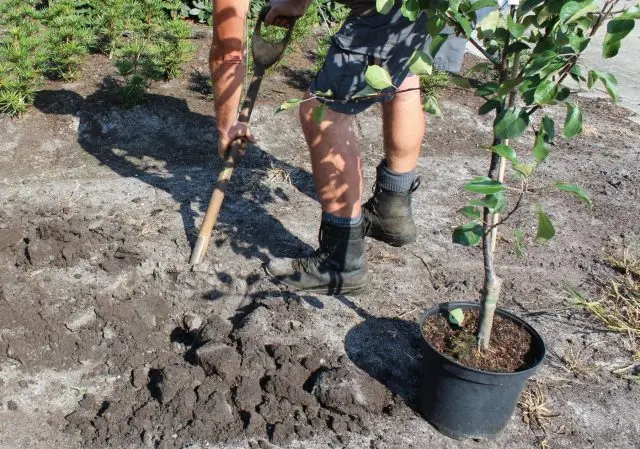
The order of planting pear Rossoshanskaya:
- First, they dig a hole 60 cm in size and 50 cm deep.
- In fertile soil mixed with 30 kg of compost, 400 g of superphosphate and 180 g of potassium salt.
- Half of the substrate is poured into the pit and rammed.
- A small hill is formed from the remaining soil, a seedling is placed on it.
- The roots of the plant are covered with earth.
- The soil is well compacted and watered.
After planting, the pear is watered every week. The soil is mulched with humus. In the next 2 – 3 years, the culture does not require top dressing.
Watering and top dressing
It is enough to water the Rossoshanskaya pear before and after flowering. Moisture is necessary for the tree to form ovaries. 3-4 buckets of warm water are poured into the trunk circle. Additional watering is possible in dry weather. Moisture should not stagnate in the ground. After watering loosen the soil and mulch with peat. In autumn, the last winter watering is performed.
During the season, the culture is fed 3-4 times. In early spring, nitrogen fertilizers are applied: a solution of urea or mullein. Top dressing stimulates the growth of green mass. After flowering, the tree is fed with a solution of Nitroammophoska.
For 10 liters of water, add 40 g of superphosphate and potassium salt. The solution is poured under the root or embedded in the soil before watering. Top dressing is repeated in mid-September so that the tree gains strength after fruiting. Instead of minerals, bone meal or wood ash is used.
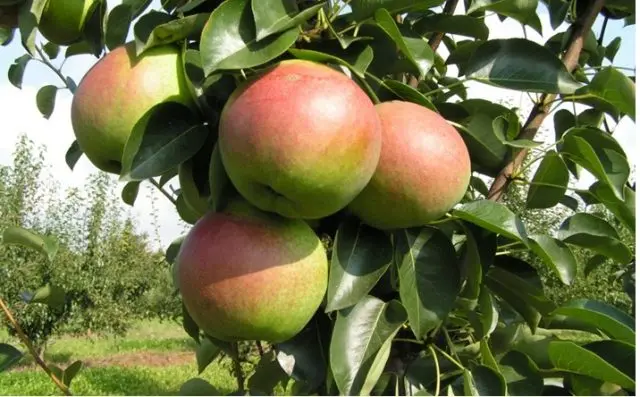
Trimming
The pear is cut in early spring, before sap flow begins. For a tree, a pyramidal crown is formed. The first treatment is carried out immediately after disembarkation. The center conductor is shortened by ¼. Skeletal shoots are determined, the remaining processes are cut off. Broken, frozen and diseased branches are removed annually. It is allowed to prune in the fall, when the leaf fall is over.
Whitewash
Whitewashing is carried out in November or early March. The procedure protects the tree bark from temperature changes and spring burns. In the process of whitewashing, the larvae of pests wintering on trees are destroyed.
It is allowed to use the finished composition or make it yourself from water, lime and clay. In a pear, the lower part of the trunk is processed from skeletal shoots to the ground. Whitewashing is necessary for adult and young trees. For seedlings, a less concentrated mixture is obtained.
Preparation for winter
Preparation of pears for winter begins in late autumn. The tree is watered so that the moist soil protects it from the cold. Then they spud the trunk with earth and pour a layer of mulch from humus.
Young plants need additional protection from the cold. A wooden frame is built over the pear and agrofiber is attached. From above landing cover spruce branches. Polyethylene, which does not allow moisture and air to pass through, is not suitable for shelter.
Pollination
For the formation of ovaries, a pear requires pollinators. For planting choose varieties that bloom at the same time. On the process of pollination in other factors: warm weather, lack of rain, cold and heat. A pear is planted on a plot with an interval of 3 – 4 m. If it is not possible to place several trees, then a resistant stock is chosen. Different varieties are grafted into the crown.
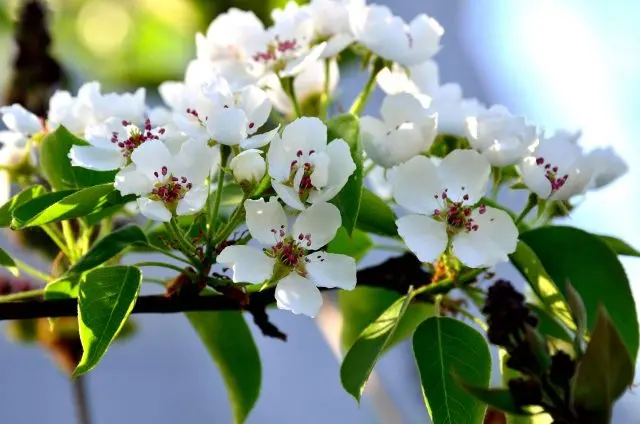
The best pollinators for pear Rossoshanskaya:
- Marble. The variety is widely distributed in the Central and Central Black Earth region. Medium-sized tree with a wide pyramidal crown. Fruits weighing 160 g, correctly conical in shape. The skin is dense, green-yellow with a reddish marble blush. The variety is valued for winter hardiness and fruit quality. The main disadvantage is sensitivity to lack of moisture.
- Tatyana. Autumn variety, is a tall tree with a rare crown. Fruits weighing up to 230 g. The pulp is creamy and sweet. The color is yellow-golden with a blurred blush. The variety has dessert qualities and winter hardiness. Weakly affected by scab and powdery mildew.
- Autumn Yakovleva. A variety of autumn fruiting, found in the middle lane. The tree grows rapidly and forms a rounded drooping crown. The fruits are medium in size, greenish-yellow in color with a blurred blush. The pulp is homogeneous, tender, oily. Needs scab treatment.
Ripening pear Rossoshanskaya
The period of fruit ripening depends on the variety. In the second half of August, the Rossoshanskaya Early pear is harvested. The variety belongs to the summer, the fruits are stored for 30 days. The ripening period of the Rossoshanskaya Beautiful pear in the Chernozem region is mid-August. The fruits are suitable for consumption within a month.
The Dessertnaya variety yields in early September. Fruits are stored no more than 80 days. Pear Rossoshanskaya Late bears fruit in mid-late September. In cool conditions, the fruits are kept until January.
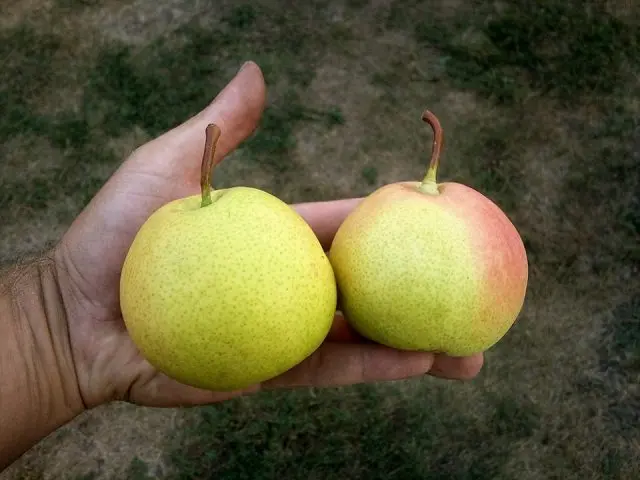
Productivity
Pear Rossoshanskaya stably bears fruit. The first fruits are removed 5-7 years after planting. Peak fruiting occurs at the age of 11 – 15 years.
Productivity is largely determined by the variety:
- Beautiful – up to 80 kg per tree;
- Dessert – 70 kg;
- Early – from 70 to 80 kg;
- Late – 30 kg.
Diseases and pests
The most dangerous disease for the Rossosh pear is scab. The lesion has the appearance of dark dots that appear on leaves, fruits and flowers. Gradually, the spots increase to 2 – 3 cm. As a result, the fruits become small and hard, their taste and presentation are lost. To combat scab, drugs Scor, Strobi, Horus are used. Processing is carried out every 2 weeks.
The pear attracts the sucker, leafworm, codling moth, aphids and other pests. Insects feed on the sap of the tree, which slows down its growth and reduces the yield. To get rid of pests, insecticides Agravertin, Iskra, Decis are used. Trees are sprayed with working solutions on the leaf. Digging up the soil in the trunk circle and whitewashing the trunk is a good prevention.

Reviews about pear Rossoshanskaya
Conclusion
Description, photos and reviews of the Dessert Rossoshanskaya pear will help gardeners find suitable seedlings for growing. The group of varieties is characterized by high yield and good taste of fruits. Plantings are provided with constant care: watered, fed, cut the crown.









